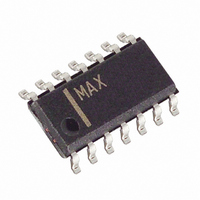MAX773ESD+ Maxim Integrated Products, MAX773ESD+ Datasheet - Page 16

MAX773ESD+
Manufacturer Part Number
MAX773ESD+
Description
IC CNTRLR DC-DC 8-SOIC
Manufacturer
Maxim Integrated Products
Type
Step-Up (Boost)r
Datasheet
1.MAX770CSA.pdf
(20 pages)
Specifications of MAX773ESD+
Internal Switch(s)
No
Synchronous Rectifier
No
Number Of Outputs
1
Voltage - Output
5V, 12V, 15V, Adj
Current - Output
1A
Frequency - Switching
300kHz
Voltage - Input
3 ~ 16.5 V
Operating Temperature
-40°C ~ 85°C
Mounting Type
Surface Mount
Package / Case
14-SOIC (3.9mm Width), 14-SOL
Power - Output
667mW
Output Voltage
5 V, 12 V, 15 V, 3 V
Output Current
1 A
Input Voltage
3 V to 16.5 V
Mounting Style
SMD/SMT
Maximum Operating Temperature
+ 85 C
Minimum Operating Temperature
- 40 C
Lead Free Status / RoHS Status
Lead free / RoHS Compliant
The standard operating circuits use a 22µH inductor.
If a different inductance value is desired, select L
such that:
Larger inductance values tend to increase the start-up
time slightly, while smaller inductance values allow the
coil current to ramp up to higher levels before the
switch turns off, increasing the ripple at light loads.
Inductors with a ferrite core or equivalent are recom-
mended; powder iron cores are not recommended for
use with high switching frequencies. Make sure the
inductor’s saturation current rating (the current at which
the core begins to saturate and the inductance starts to
fall) exceeds the peak current rating set by R
However, it is generally acceptable to bias the inductor
into saturation by approximately 20% (the point where
the inductance is 20% below the nominal value). For
highest efficiency, use a coil with low DC resistance,
5V/12V/15V or Adjustable, High-Efficiency,
Low I
Figure 8a. Use an N-Channel MOSFET with the
MAX770/MAX771/MAX772
Figure 8b. Using an N-Channel MOSFET with the MAX773
16
______________________________________________________________________________________
Q
L ≥ ——————————
, Step-Up DC-DC Controllers
MAX773
MAX770
MAX771
MAX772
V
IN
(max) x t
EXTH
EXTL
CS
I
EXT
CS
LIM
/ 2
ON
(min)
N
N
R
L
R
SENSE
SENSE
SENSE
.
preferably under 20mΩ. To minimize radiated noise,
use a toroid, a pot core, or a shielded coil.
Table 2 lists inductor suppliers and specific recom-
mended inductors.
Use an N-channel MOSFET power transistor with the
MAX770/MAX771/MAX772 (Figure 8a).
Use an N-FET whenever possible with the MAX773. An
NPN transistor can be used, but be extremely careful
when determining the base current (see NPN
Transistors section). An NPN transistor is not recom-
mended when using the shunt regulator.
To ensure the external N-channel MOSFET (N-FET) is
turned on hard, use logic-level or low-threshold
N-FETs when the input drive voltage is less than 8V. This
applies even in bootstrapped mode, to ensure start-up.
N-FETs provide the highest efficiency because they do
not draw any DC gate-drive current, but they are typi-
cally more expensive than NPN transistors. When using
an N-FET with the MAX773, connect EXTH and EXTL to
the N-FET’s gate (Figure 8b).
When selecting an N-FET, three important parameters
are the total gate charge (Q
and reverse transfer capacitance (C
Q
charging the gate. Use the typical Q
results; the maximum value is usually grossly over-
specified since it is a guaranteed limit and not the mea-
sured value. The typical total gate charge should be
50nC or less. With larger numbers, the EXT pins may
not be able to adequately drive the gate. The EXT
rise/fall time with various capacitive loads as shown in
the Typical Operating Characteristics .
Figure 8c. Using an NPN Transistor with the MAX773
g
takes into account all capacitances associated with
MAX773
EXTH
EXTL
Power Transistor Selection
CS
I
B
R
g
BASE
), on resistance (r
I
C(PEAK)
N-Channel MOSFETs
RSS
g
).
NPN
L
R
value for best
SENSE
DS(ON)
),











